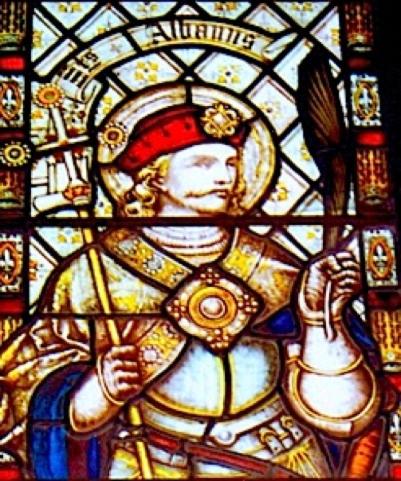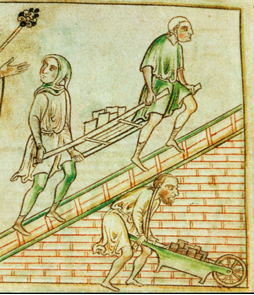
The fifteenth-century Cooke Manuscript, the oldest of the Gothic Constitutions of Freemasonry, describes St. Alban as the first patron of the Craft in England. It gives an account of the legend of St. Alban and his patronage of the stonemasons of that day:
"And soone after that come St. Adhabell into Englond, and he convertyd St. Albon to cristendome. And St. Albon lovyd masons well, and he gaf them fyrst her charges and maners fyrst in Englond. And he ordeyned convenyent [wages] to pay for their travayle."
The Grand Lodge Manuscript of 1583, includes another account:
"Inglande in all this season stode voyde of any chardge of Massonrie until St. Albon's tyme, and in his dayes, the Kyng of Ingland that was a pagyn he did wall thee toune aboute that is called St. Albons, and St. Albon was a woorthy Knighte and Stewarde to the Kyngs householde ... and loved Massons well ... and he made their paye right good.... And he gave them a Charter of the Kyng & his counsell for to houlde a Genrall Counsell.... After the decease of Saynte Albon ... the good rule of Massonry was destroyed vntil the tyme of Athelstone that was a woorthy Kyng of England."
The anonymous work titled The Complete Free Mason or Multa Paucis for the Lovers of Secrets, published at London in 1764, states that St. Alban was appointed "Grand Master of Masons," who employed the Fraternity in building the palace at Verulamium, or St. Albans, in Hertfordshire.
The Feast of St. Alban is observed on 22 June of each year.
The Legend of St. Alban
Regarded as the first martyr of England, legend holds that St. Alban was born in the third century in the English Roman town of Verulamium, now St. Albans in Hertfordshire.
According to the Venerable Bede's Ecclesiastical History of the English People, Alban was a pagan who converted to Christianity. According to Geoffrey of Monmouth, Alban sheltered a Christian priest, and hid him during the persecution of Christians. When the magistrate sent soldiers to Alban's home looking for the priest, Alban hid the priest and offered himself to the soldiers after disguising himself by donning the priest's cloak. Alban was taken before the magistrate, who was furious for the deception, and condemned Alban to death. Alban replied with these words: "I worship and adore the true and living God who created all things."
In the year 793, the Anglo-Saxon King Offa of Mercia constructed a church and episcopal palace on the site of St. Alban's martyrdom. The church later became a Benedictine monastery and the abbey church of St. Alban.

Stonemasons under the direction of King Offa of Mercia building St. Alban's Church at Verulamium, now St. Albans in Hertfordshire, England.
International Lodges Named St. Alban:
Today, there are about two dozen Masonic lodges around the world named for St. Alban. Four of these are in England, fifteen in the United States, two in Canada, and three in South Africa, Australia and New Zealand. Since 1954, representatives of these lodges have held Annual Gatherings in different locations, normally on the east coast of the U.S., in Canada and England.